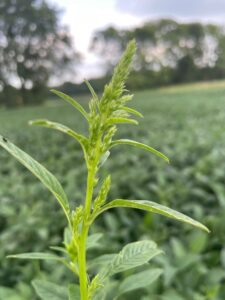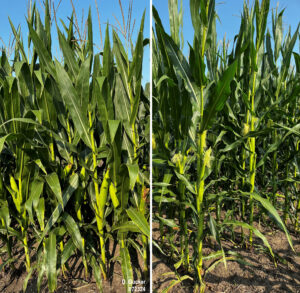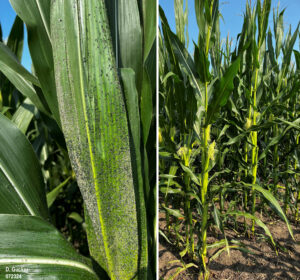Illinois Crop Update – July 26, 2024
Kathryn Seebruck – Commercial Agriculture Educator
Stephenson County
Soil Conditions: Moderately Wet (soil is damp, standing water may be present in low areas, water bodies are full)
After last week’s storms, the corn that was most heavily impacted (which was minimal) has mostly come back up. Everything still looks very healthy as we continue to receive rainfall. Corn is silking and soybeans are anywhere between R3 and R5. I have seen some rootworm beetles and subsequent silk clipping but not in high amounts. Soybeans have some Japanese beetle feeding but it’s very minimal. I also have not seen any significant disease pressure
Russ Higgins – Commercial Agriculture Educator
Grundy County
Soil Conditions: Near Normal
Another week of varied precipitation in northeast Illinois, but mostly favorable growing conditions. Corn has reached R3 (milk stage). At this stage the moisture of the kernel is about 80%. Leaf disease incidence continues to be low in corn and soy fields visited. Most soy is R3 to R4, beginning to full pod. In addition to the crops entering their reproductive stages, so too are some weeds, including waterhemp. This weed is dioecious, both male and female plants having flowering structures. Once mature, the plants can be easily sexed by the presence or lack of shiny black seeds.
This week I attended the Monmouth Research Center Agronomy Day and was able to gain insight explaining why many were seeing waterhemp uncontrolled by post herbicide applications. The surviving plants appeared weeks after the post herbicide application as bushier, more robust plants. University of Illinois ‘s Caleb Wepprecht discussed “HPPD Resistant Waterhemp- A Growing Concern” and shared his take on weed control challenges from this year. A few factors in waterhemp escapes were inadequate spray volume on larger plants, leading to inadequate coverage of the growing points, even with systemic herbicides, as well as low use rates/dosage of herbicide in the weed itself, along with the concept of metabolic herbicide resistance, leading to the waterhemp’s survival and altered plant structure. As farmers see waterhemp escapes in fields, Caleb encouraged attendees to take whatever steps possible to prevent the prolific seed-producing weed from maturing and causing future concerns

Figure 1: R3 corn – milk stage

Figure 2: Waterhemp – reproductive stage
Reagan Tibbs – Commercial Agriculture Educator
Logan County
Soil Conditions: Near Normal
Corn and soybeans across the area continue to look healthy, and growing progress remains steady. Many corn fields have been successfully pollinated. Spray planes have also been active the last couple of weeks, with producers putting on fungicides. Soybeans have nearly all flowered, with most also starting to grow pods. Some rain would be welcome, but there does not appear to be a lack of moisture in the soil.
Doug Gucker – Local Food Systems and Small Farms Educator
Dewitt, Macon, and Piatt County
Soil Conditions: Near Normal
In general, the corn and soybean fields look good. Weed escapes are beginning to show in a few soybean fields. Early planted soybean fields are in the R3 stage. Early planted corn fields are R3 stage with late planted fields in R1 (silking) stage. Corn leaf aphids are making a presence in the R1 corn fields, but at this time there is no need to apply control measures. Silking corn fields should be monitored for aphid numbers and whether the crop is suffering moisture stress. Current IL thresholds for aphid control in corn is >50% of the corn plants have more than 100 aphids per plant and the plant is in moisture stress; OR >3% of the corn plants have heavily infested tassels and upper corn leaves plus suffering moisture stress. Remember aphids are controlled by insect predators, diseases and rainfall washing them off.

Figure 3: More mature fields are reaching R3 stage.

Figure 4: Corn R3 stage to left and R1 corn on the right

Figure 5: R1 Corn is showing elevated corn leaf aphid numbers, but not near the thresholds that insecticide needs to be applied.
Talon Becker – Commercial Agriculture Specialist
Vermilion County
Soil Conditions: Mildly Wet (soil is wetter than normal, local vegetation is healthy)
This week, I went east and surveyed the southern half of Vermilion County. Overall, the corn and soybean crop looked healthy, and soil conditions were near ideal to only mildly wet in most areas. However, there were some low-lying soybean fields showing pockets of stressed plants showing symptoms of root rot and a few instances where the plants have died. This has been a common observation of my past few reports in surrounding counties with differing levels of severity. In southern Vermilion County currently, crop loss appears to be lower than it is a bit further west and southwest. Most soybean fields I stopped at were at late R2 to early R3. Japanese beetles are easy to find in most fields, but defoliation levels were still well below threshold in fields I stopped at. Most corn was R1-R2, and as noted by Nick Seiter and Doug Gucker, a few of the fields surveyed had corn leaf aphid colonies present.

Figure 6: Soybean stand loss due to flooding

Figure 7: Corn leaf aphid colony with winged adults (alates)

Figure 8: Corn ears at late R1 (left) and late R2 (right)
Nick Seiter – Extension Field Crops Entomologist
Champaign County
Soil Conditions: Mildly Wet (soil is wetter than normal, local vegetation is healthy)
I have had many reports of corn leaf aphids over the last couple of weeks, including several in pre-tassel corn. Corn leaf aphids are usually found inside of the upper whorl (unlike other species which are primarily found on the undersides of leaves) and are darker in color than other species we see in corn. This year, the wide variety of planting dates has resulted in corn that is all over the place in terms of stage – these aphids are particularly a problem if they are present in large numbers during pollination. (Fortunately, where we have adequate moisture and cool temperatures during pollination, this effect will be minimized). Consider an insecticide if 50% of plants have aphid colonies (~50-100 aphids) prior to or during R1. Once pollination has passed, it takes much greater numbers to cause yield loss.





